Oscar P. Fitzgerald’s American Furniture: 1650 to the Present (Rowman & Littlefield, 2018, 621 pages) is a door-stopper book, a behemoth with well over a thousand photographs, some in color, most black-and-white, and as promised by the title, a history of American furniture and craftsmanship since the time of the thirteen colonies.
Both connoisseurs and those who know almost nothing about furniture other than how to sit in a chair—I count myself in the latter crew—will unearth a cache of diamonds in Fitzgerald’s history. In this review we must content ourselves with examining just a few of these treasures.
We learn that the Pennsylvania Germans, for example, hailed from the south of Germany and so brought with them the tradition of painted furniture, including the use of hex signs on various chests. Of the Moravians, such as those who settled around present-day Winston-Salem, Fitzgerald informs us that “Music was an important part of a Moravian schools curriculum, necessitating specialized Windsor chairs with extra-long legs for use by trombone players.” Following World War II, Fitzgerald tells us, the public was ready for a new simplicity in furniture design and a greater informality in their way of living, a demand that brought forth such innovations as modular sofas. Fiberglass chairs such as the ones used in so many schoolrooms came into widespread beginning in the 1950s, glass-top tables become popular, and designers like those of the Memphis school set out to create furniture offering social commentary. (According to Fitzgerald, this movement, founded originally by some Italian architects, takes its name Memphis from both the cradle of civilization in Egypt and from the home of Elvis Presley in Tennessee, and was inspired by Bob Dylan’s song “Stuck Inside of Mobile with the Memphis Blues Again,” an amusing stew, especially given current anxieties regarding “cultural appropriation.”)
When we think of American furniture, even those of us who know little of its history call to mind the influence of the Shakers, that religious sect whose members were known for their dancing and shaking during worship services. Here, as he does throughout American Furniture, Fitzgerald shows us the influence of philosophy and culture on design. In their crafting of furniture, the Shakers followed the ideals as expressed in their most famous of hymns, “Tis a gift to be simple.” They further believed that “Beauty rests on utility” and that “useless ornament might encourage pride.” Finally, as Mother Ann Lee, the founder of the American Shakers, told her followers, “Do all your work as though you had a thousand years to live on earth, and as you would as if you knew you must die tomorrow.” That maxim led Shakers to regard all labor, including the building of chairs and tables, as holy, with the result being the excellent workmanship associated with their furniture.
After the Civil War, the Shakers with their belief in celibacy and the separation of the sexes, and plagued by a diminishing religious zeal among their members, began dying out. Yet in their furniture building, as Fitzgerald demonstrates, “the Shakers were one hundred years ahead of their time in their concept of design,” and “Shaker furniture surged in popularity in the 20th century as simplicity became the order of the day.”
As in other arts and crafts, American furniture and its manufacture brought together styles from around the globe. In writing of the aesthetic movement of the 1880s to the close of the century, for example, which can best be summed up by Oscar Wilde’s “art for art’s sake,” we find some makers of furniture blending a medieval style with Oriental and naturalistic impulses. In a picture of a sideboard made by the Herter brothers, German immigrants to New York, Fitzgerald shows us this style of Modern Gothic; this cabinet with its ornate carvings, including the sunflowers that were a symbol of the aesthetic movement, looks as if some mysterious force had whisked it from a late medieval manor house to a Boston drawing room.
In addition to his lavish use of photographs and their accompanying commentary, Fitzgerald, a renowned expert on furniture, a teacher, and a curator, deserves our applause for the wealth of information he has packed into these pages and the straight-up style with which he delivers this gift. As I mentioned earlier, American Furniture offers its riches not only to academics, architects, and artists, but to all of us who know little about the history of furniture and its place in our homes and offices. And like the admirable Shakers, Fitzgerald practices simplicity and lack of ornamentation in his writing. He keeps himself in the background, a docent who, as he takes us on tour, remains a teacher with much knowledge and few opinions, a man possessed of an enviable neutrality, who is equally enthusiastic about colonial beds and postmodernist lecterns.
Near the end of American Furniture, in a chapter on the care and preservation of furniture, Fitzgerald offers this quote by one Charles Montgomery: “Anyone who aspires to become a connoisseur must first learn to see, and then must look and look and look and remember what he sees.”
Oliver Fitzgerald long ago learned to see. He has looked and looked and looked, and remembered what he has seen. Fortunately, he has chose to share that vision with the rest of us in American Furniture.
We learn that the Pennsylvania Germans, for example, hailed from the south of Germany and so brought with them the tradition of painted furniture, including the use of hex signs on various chests. Of the Moravians, such as those who settled around present-day Winston-Salem, Fitzgerald informs us that “Music was an important part of a Moravian schools curriculum, necessitating specialized Windsor chairs with extra-long legs for use by trombone players.” Following World War II, Fitzgerald tells us, the public was ready for a new simplicity in furniture design and a greater informality in their way of living, a demand that brought forth such innovations as modular sofas. Fiberglass chairs such as the ones used in so many schoolrooms came into widespread beginning in the 1950s, glass-top tables become popular, and designers like those of the Memphis school set out to create furniture offering social commentary. (According to Fitzgerald, this movement, founded originally by some Italian architects, takes its name Memphis from both the cradle of civilization in Egypt and from the home of Elvis Presley in Tennessee, and was inspired by Bob Dylan’s song “Stuck Inside of Mobile with the Memphis Blues Again,” an amusing stew, especially given current anxieties regarding “cultural appropriation.”)
When we think of American furniture, even those of us who know little of its history call to mind the influence of the Shakers, that religious sect whose members were known for their dancing and shaking during worship services. Here, as he does throughout American Furniture, Fitzgerald shows us the influence of philosophy and culture on design. In their crafting of furniture, the Shakers followed the ideals as expressed in their most famous of hymns, “Tis a gift to be simple.” They further believed that “Beauty rests on utility” and that “useless ornament might encourage pride.” Finally, as Mother Ann Lee, the founder of the American Shakers, told her followers, “Do all your work as though you had a thousand years to live on earth, and as you would as if you knew you must die tomorrow.” That maxim led Shakers to regard all labor, including the building of chairs and tables, as holy, with the result being the excellent workmanship associated with their furniture.
After the Civil War, the Shakers with their belief in celibacy and the separation of the sexes, and plagued by a diminishing religious zeal among their members, began dying out. Yet in their furniture building, as Fitzgerald demonstrates, “the Shakers were one hundred years ahead of their time in their concept of design,” and “Shaker furniture surged in popularity in the 20th century as simplicity became the order of the day.”
As in other arts and crafts, American furniture and its manufacture brought together styles from around the globe. In writing of the aesthetic movement of the 1880s to the close of the century, for example, which can best be summed up by Oscar Wilde’s “art for art’s sake,” we find some makers of furniture blending a medieval style with Oriental and naturalistic impulses. In a picture of a sideboard made by the Herter brothers, German immigrants to New York, Fitzgerald shows us this style of Modern Gothic; this cabinet with its ornate carvings, including the sunflowers that were a symbol of the aesthetic movement, looks as if some mysterious force had whisked it from a late medieval manor house to a Boston drawing room.
In addition to his lavish use of photographs and their accompanying commentary, Fitzgerald, a renowned expert on furniture, a teacher, and a curator, deserves our applause for the wealth of information he has packed into these pages and the straight-up style with which he delivers this gift. As I mentioned earlier, American Furniture offers its riches not only to academics, architects, and artists, but to all of us who know little about the history of furniture and its place in our homes and offices. And like the admirable Shakers, Fitzgerald practices simplicity and lack of ornamentation in his writing. He keeps himself in the background, a docent who, as he takes us on tour, remains a teacher with much knowledge and few opinions, a man possessed of an enviable neutrality, who is equally enthusiastic about colonial beds and postmodernist lecterns.
Near the end of American Furniture, in a chapter on the care and preservation of furniture, Fitzgerald offers this quote by one Charles Montgomery: “Anyone who aspires to become a connoisseur must first learn to see, and then must look and look and look and remember what he sees.”
Oliver Fitzgerald long ago learned to see. He has looked and looked and looked, and remembered what he has seen. Fortunately, he has chose to share that vision with the rest of us in American Furniture.






 RSS Feed
RSS Feed